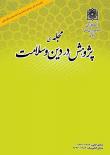نمذجة اتّجاه طلاّب جامعة إصفهان للعلوم الطبّيّة إلى التربية الدينيّة بناءً على نظريّة أیزن و فیشبین
مجلة البحث في الدین و الصحه,
مجلد 2 عدد 4 (2016),
27 دی 2017
,
الصفحة 34-25
الملخص
لتحميل النسخة الكاملة لهذه المقالة انقر هنا
السابقة والأهداف:بالنظر إلى أنّ معتقدات وسلوكيّات الطبيب الدينيّة تؤثّر في كيفيّة علاجه، فتمّ هذا البحث بهدف نمذجة اتّجاه طلاّب جامعة إصفهان للعلوم الطبّيّة إلى التربية الدينيّة.
الموادّ والأساليب: في هذه الدراسة الوصفيّة التضامنيّة، تمّت دراسة 154 طالبًا لجامعة إصفهان للعلوم الطبّيّة بطريقة أخذ العيّنات العشوائيّة البسيطة. و قد استفيد من الاستمارة المحقّقة الصحيحة والموثوقة(92/0α=) لجمع المعلومات على أساس متغیّرات نموذج أیزن و فیشبین، كما استفيد لدراسة المعطيات من التحليل العامليّ التوكيديّ على أساس المعادلات البنائيّة بالتمتّع بالبرمجيّة الإحصائيّةAMOS .
المكشوفات: قد كشفت مكشوفات البحث أنّ مكوّن الاتّجاه إلى التربية الدينيّة، مع عامل الحمولة 41/0، يؤثّر في مكوّن السلوك الدینیّ. وإضافة إلى هذا، إنّ لكمّيّة التضامن بین مكوّن الاتّجاه والقواعد الذهنیّة معنى أيضًا(58/0). ويؤثّر نطاق القواعد الذهنیّة على مكوّن القصد عن التربية الدينيّة مع عامل الحمولة 78/0، و في النهاية يؤثّر النطاق نفسه، على السلوك الدینیّ مع عامل الحمولة 31/0 أيضًا. وبناءً على نتیجة البحث، قد تبيّن أنّ لعامل التعليم مع عامل الحمولة 77/0، أكثر أهمّیّة بين عوامل الاتّجاه إلى التربية الدينيّة؛ ووقعت مكوّنات الأصدقاء والأقرباء والأسرة ووسائل الإعلام في مرتبة بعد المكوّنات المذكورة آنفًا من حيث الأهمّيّة في الاتّجاه إلى التربية الدينيّة.
النتیجة: بالنظر إلى أنّه في هذا البحث،كان لعامل التعليم أكثر تأثير، فالعناية إلى هذا العامل في تربية الأطبّاء الدينيّة لازمة جدًّا.
لتحميل النسخة الكاملة لهذه المقالة انقر هنا
- الاتّجاه، العوامل، السلوك، التربية الدينيّة
كيفية الاقتباس
المراجع
Keshavarz S. Indicators and damage of religious education. Journal of Islamic education. 2006; 6(3): 93-122. (Full Text in Persian)
Masoodi H, MazlomeKhorasani M, Noghani M. The effects of a father's role in the religious education of children in families city of Mashhad. Biquarterly Journal of Islamic Education.2015; 10(20): 141-62. (Full Text in Persian)
Bertram‐Troost GD, de Roos S, Miedema S. Religious identity development of adolescents in religious affiliated schools. A theoretical foundation for empirical research. Journal of Beliefs & Values. 2006; 27(3): 303-14. (Full Text in Persian)
Sadeghzadeh GH. Role of spiritual intelligence in religious education in religious education articles. Religious Education Conference; Qom: Research Institute of Imam Khomeini;2009. (Full Text in Persian)
HajiDehabadi MA. The pathology religious education. Qom: Institute of seminary and university; 2002. (Full Text in Persian)
Delbari M. Religious educational damages of view Shahid Beheshti. Conference on Education; Tehran: Roshd; 2006. (Full Text in Persian)
AbadiVaighan KH, Mazenabkhodei M. Identify and examine factors affectingthe credibility of religious education adolescents. The first International Congress on Culture and Religious Thought; 2015. (Full Text in Persian)
Zandwaniyan Naiiny A, Dehghani Ashkezari M, Tayyebi R. The inclination of female high school student in sadooq City(yazd province). Journal of Islam and educational research 2010; 5(1): 109-25. (Full Text in Persian)
Barati H. Factors affecting the religious education of children. Tehran: Tehran University; 1996. (Full Text in Persian)
AghaeiMeibodi F. Investigate the factors contributing to the growth and consolidation of religious beliefs third year students high school Ardekan city. Yazd: Management and Research Yazd; 2007. (Full Text in Persian)
Salmanzadeh A, Farhadi P. Factors affecting religious education from the perspective Quran and Hadith. The first GlobalConference on the Sustainable Development of Education and Psychology, Social and Cultural Studies; Tehran: Arvand Mehr institutions of higher learning, The strategies to achieve sustainable development;2014. (Full Text in Persian)
Salehi A, Tahami R. Analysis of factorsand barriers affecting religious education based on the words of Imam Ali(as) in Nahjolbalaghe. Journal of Islamic Education. 2009; 4(9): 75-94 .(FullText in Persian)
Karimi Y. Social psychology theories, concepts and applications. Tehran: Arasbaran; 2012. (Full Text in Persian)
Shahbazi M, Ghorbani F. Effective factors on Tendency of Students Tabriz Universities to Join Entrepreneur Cooperatives. Co-Operation and Agriculture. 2009; 18(4): 11-31. (Full Text in Persian)
Barati AK, Ramezani M, Mozafareamini A, Alibigi AM. Attitude and orientation Esfahan provincefarmers Than participate in training courses and agricultural extension. Based on model, Fishbin & Aizen. Journal of Agricultural Research Management. 2014; 29(3): 63-73. (Full Text in Persian)
Taleban MR. Relationship youth tendency to pray with subjective norms. Journal ofmarefat. 2014; 8(1): 2-21. (Full Text in Persian)
Ajzen I, Fishbein M. Understanding attitudes and predicting social behaviour; 1980.
Friberg K. Apprenticeship orientation as planned behavior in educational choices: a path model of antecedent beliefs. Empirical Research in Vocational Education and Training. 2014; 6(1): 1.
Stock RM, Hoyer WD. An attitude-behavior model of salespeople’s customer orientation. Journal of the academy of marketing science. 2005; 33(4): 536-52.
Baumgartner H, Pieters R, Bagozzi RP. Future‐oriented emotions: conceptualization and behavioral effects. European Journal of Social Psychology. 2008; 38(4): 685-96.
Ghazvini MK. Holistic medicine Imam Sadeq AS. Tehran: Message of justice; 2009. (Full Text in Persian)
Enjoo SA, Mosavat SH, Heydari M. Medical Ethics in Iranian Traditional Medicine: A Review of Qutb al-Din al-Shirazi’s Ethical Code. Journal of research on History of Medicine. 2014; 3(3): 113-22. (Full Text in Persian)
MotamedJahromi M, Dehghani L. Attitude to the principles of medical ethics and its compatibility with Islamic ethics. Journal of Babol University of Medical Sciences. 2014; 2(82): 29-35. (Full Text in Persian)
Tavakoli G, Saranyzadeh M. Historical study Razi Medical Ethics. Journal of Medical History. 2013; 3(16): 53-74. (Full Text in Persian)
Karimi A. Religious education. Tehran: Publications Ghadiani; 2008. (Full Text in Persian)
- الملخص المشاهدات: 305 الأوقات
